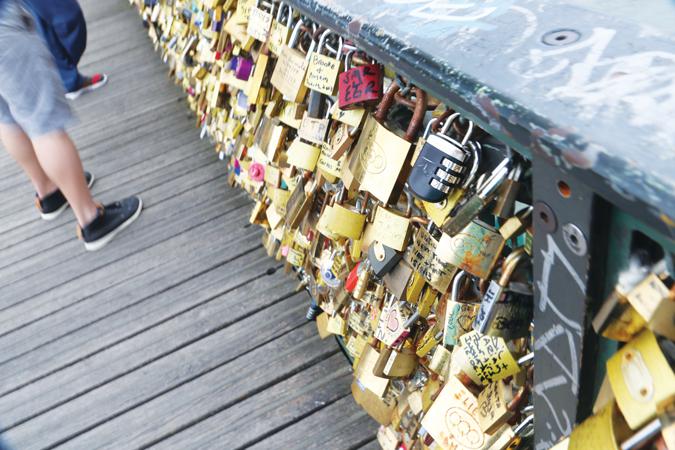A funny thing has started happening to bridges around the globe. As part of a worldwide trend, they are being taken over by lovers, eager to attach their feelings to a public sentiment. Think of it like throwing pennies into a fountain of previous generations—only for love. A person, or couple, takes an ordinary padlock, writes both their own initials and those of their lovers on it, and throws the key down into the waters below—thus securing their love as fixed in time and place through an inanimate object. While that may seem silly to some, we have certainly given more sentiment to lesser fixtures throughout history.
While it is tough to get an exact date of when the practice of love-locks (not to be confused with Locks of Love, the similarly named non-profit Cancer charity) started, and speaking quite roughly geographically, it seems to have began in Europe around the start of the new century. From Paris to Italy, Russia to Prague, these padlocked symbols of love are popping up everywhere. In Paris, the Pont des Arts, Passerelle Léopold-Sédar-Senghor and the Pont de l’Archevêché bridges have been a huge hit (one notable factor here is that they have popped up in several different places as local authorities began to crack down on the process); the Ponte Vechio in Florence, Italy as well had grown to approximately 5,500 locks before previously being cut down. Still, nobody can say for certain exactly what the origin of this public sentiment is.
In Rome, it is believed that the ritual of affixing love padlocks to the bridge Ponte Milvio can be attributed to the 1992 book Three Meters Above the Sky, by Italian author Federico Moccia (some may better know the film adaptation of same: Tre Metri Sopra il Cielo). Perhaps the oldest speculative inspiration of the love-locks story however, is that it begun in Serbia around just prior to World War II. The name of the bridge there is the Most Ljubavi (literally the Bridge of Love—now named after the love padlocks). According to local legend, a schoolmistress named Nada fell in love with a Serbian officer named Relja. After they committed to each other, Relja went to war in Greece where he fell in love with a local woman and thus broke off their engagement. Nada never recovered from that devastating blow and was rumored to have died of a broken heart. As young girls from Vrnjacka Banja wanted to protect their own loves, they started writing down their names, together with the names of their loved ones, on padlocks and affixing them to the railings of the bridge where Nada and Relja used to meet.
It seems a beautiful enough sentiment, at first, though the backlash has been rather harsh in some areas. Though it has never been proved to be true, most places cite a fear of structural damage to the bridges themselves (or other artifices, where appropriate) as the reason to not allow them. We prove to be in an interesting time though as some cities, such as Bamberg, Germany, invited people to place locks on the Kettenbrücke Bridge in 2011, only to remove them two years later when they got to be too popular. It has thus become quite a polarizing topic. It would be pretty easy to see why some municipalities are not as keen on the idea. In Dublin, for example, locks were put onto the Ha’Penny Bridge over the river Liffey, a popular tourist spot and historically protected 200+ year old location. In 2012 they were removed for fear of structural concern, but they keep returning.
One question begins to emerge as this trend grows though: does what began as the idea of a bridge that people came to from around the world to mark their love (a romantic notion indeed), begin to lose some of the appeal when it is done in multiple places around the world? Much like Disneyland, reality celebrities, or even perhaps your favorite coffee shop, these things lose their innate value as they grow more commonplace. As the trend has now grown into other objects as well—not just bridges—including a lamppost in Rome, a tree in Moscow, a fountain in Montevideo, all of which are attached with thrones of locks, one begins to wonder if the lock has any special value at all.
In perhaps the ultimate sign of just how commercial this idea of love-lock has gotten, Master locks, arguably one of the most popular companies to make locks, even has a special page dedicated to love-locks. On this page on their website, you can pick out a lock and have a custom message put on it. You can even pick a bridge, from San Francisco to Sydney, and they (supposedly) will place that lock on the bridge for you. Well, if that does not take all the romance out if it for you, I don’t know what would.
If, in the end, it is the lock itself that is so symbolic of love, and NOT the place itself that holds the value, perhaps you are better off placing the lock on your desk at home and flushing the key down the toilet. Admittedly though, since you don’t have to go too far to find your local love-lock bridge these days…were I to track one down, I would go with lock in hand—perhaps that is just the romantic in me.
Be on the lookout for love-lock bridges around the globe, wherever your travels take you.
Image courtesy of Katie Foster.








